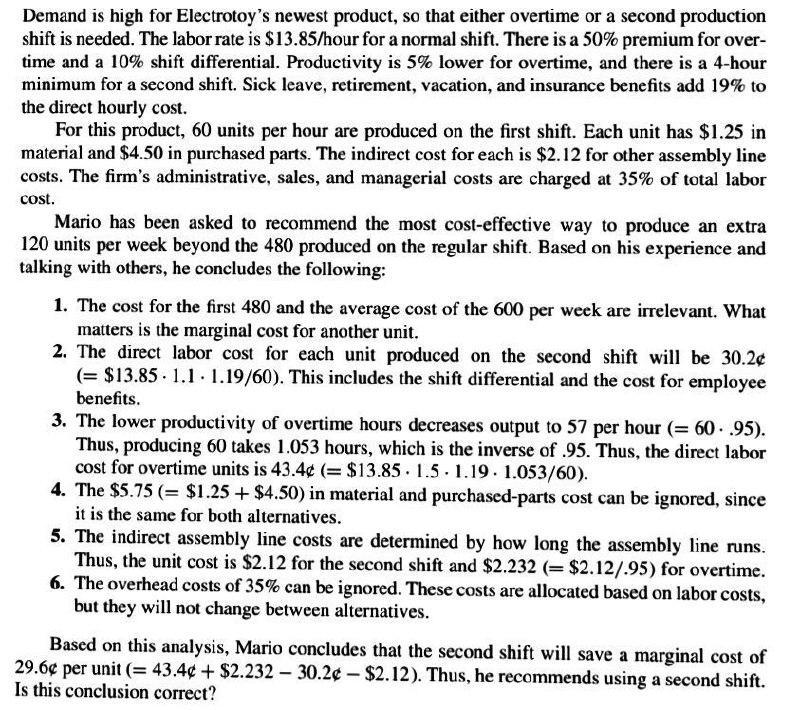Answered step by step
Verified Expert Solution
Question
1 Approved Answer
Demand is high for Electrotoy's newest product, so that either overtime or a second production shift is needed. The labor rate is $13.85/hour for

Demand is high for Electrotoy's newest product, so that either overtime or a second production shift is needed. The labor rate is $13.85/hour for a normal shift. There is a 50% premium for over- time and a 10% shift differential. Productivity is 5% lower for overtime, and there is a 4-hour minimum for a second shift. Sick leave, retirement, vacation, and insurance benefits add 19% to the direct hourly cost. For this product, 60 units per hour are produced on the first shift. Each unit has $1.25 in material and $4.50 in purchased parts. The indirect cost for each is $2.12 for other assembly line costs. The firm's administrative, sales, and managerial costs are charged at 35% of total labor cost. Mario has been asked to recommend the most cost-effective way to produce an extra 120 units per week beyond the 480 produced on the regular shift. Based on his experience and talking with others, he concludes the following: 1. The cost for the first 480 and the average cost of the 600 per week are irrelevant. What matters is the marginal cost for another unit. 2. The direct labor cost for each unit produced on the second shift will be 30.2 (= $13.85.1.1.1.19/60). This includes the shift differential and the cost for employee benefits. 3. The lower productivity of overtime hours decreases output to 57 per hour (= 60.95). Thus, producing 60 takes 1.053 hours, which is the inverse of .95. Thus, the direct labor cost for overtime units is 43.4 (= $13.85 1.5-1.19. 1.053/60). 4. The $5.75 (= $1.25 + $4.50) in material and purchased-parts cost can be ignored, since it is the same for both alternatives. 5. The indirect assembly line costs are determined by how long the assembly line runs. Thus, the unit cost is $2.12 for the second shift and $2.232 (= $2.12/.95) for overtime. 6. The overhead costs of 35% can be ignored. These costs are allocated based on labor costs, but they will not change between alternatives. Based on this analysis, Mario concludes that the second shift will save a marginal cost of 29.6 per unit (= 43.4 + $2.232 - 30.2-$2.12). Thus, he recommends using a second shift. Is this conclusion correct?
Step by Step Solution
★★★★★
3.48 Rating (145 Votes )
There are 3 Steps involved in it
Step: 1
Solution Marios analysis has one error and two weaknesses 1 The error is that he did not allow for t...
Get Instant Access to Expert-Tailored Solutions
See step-by-step solutions with expert insights and AI powered tools for academic success
Step: 2

Step: 3

Ace Your Homework with AI
Get the answers you need in no time with our AI-driven, step-by-step assistance
Get Started


